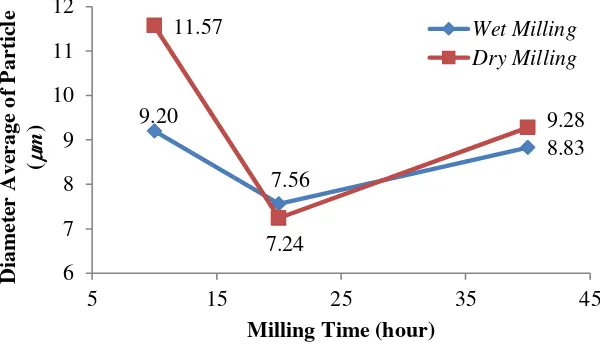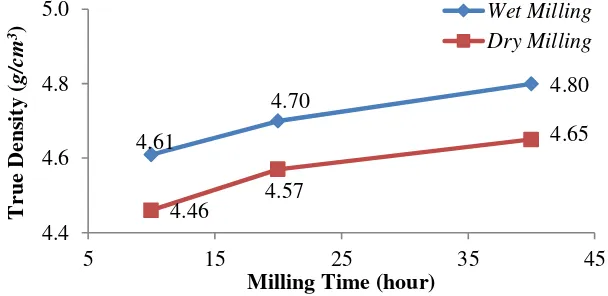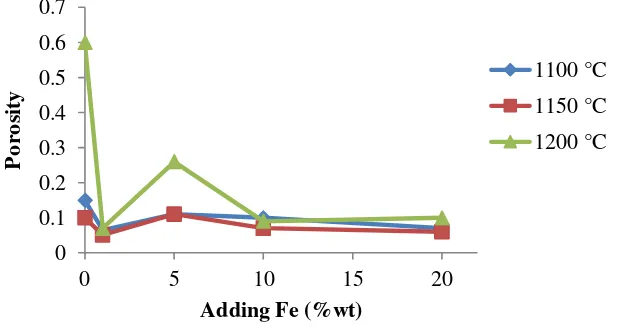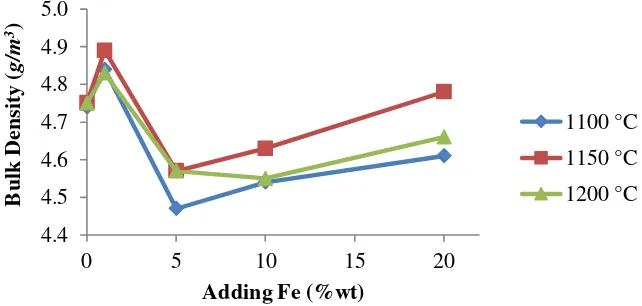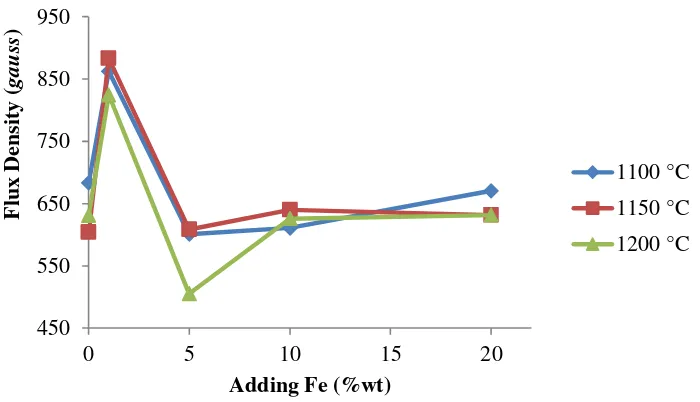PAPER • OPEN ACCESS
Study of Particle Size and Affix Fe in Permanent Magnet Materials
BaFe
12
O
19
against Their Physical Properties
To cite this article: MN Nasruddin et al 2018 J. Phys.: Conf. Ser.1116 032021
View the article online for updates and enhancements.
Study of Particle Size and Affix Fe in Permanent Magnet
Materials BaFe
12O
19against Their Physical Properties
Nasruddin MN1*, T. Khairuman2, Perdamean Sebayang3, Kerista Sebayang1, Yola
Allan Ginting1, Zikri Noer1
1 Department of Physics, Faculty of Mathematics and Sciencs, University of
Suma-tera Utara, Medan, Indonesia
powder using high energy milling, where milling time are 0, 10, 20 and 40 hours. Variations the addition affixes Fe are 1, 5, 10 and 20% of weight with sintering temperature: 1100, 1150 and 1200oC. Each temperature was hold for 1 hour. Average particle size, true density, porosity, bulk
density and magnetic flux density of the sample of BaFe12O19 are observed parameters. The
results showed that particle size decreased by 64.67% after 20 hours of milling from 21.4 m to 7.56 m. Before and after 20 hours of milling, true density also increase from 4.61 to 4.70 g/cm3.
The milling time is inversely to particle size and directly proportional to true density. The optimum condition of making a permanent magnet sample of BaFe12O19 was reached on the
addition of 1% Fe and sintering temperature 1150oC, generating porosity = 0.065%, bulk density
= 4.89 g/cm3, and the magnetic flux density = 883.3 Gauss. Increasing of Fe and sintering
temperature tends to increase the number of pores and magnification of particle size on the sample.
1. Introduction
Today, the use of magnets, especially the permanent magnet has been growing very rapidly. Barium-based permanent magnet heksaferrite (BaFe12O19) is an engineered material that is a very broad
application and once they are used in many industries in Indonesia. To fulfill the domestic needs of the magnet is needed significant production technology and quality magnets. During this time the magnetic components are still very dependent on other countries such as Japan and China [1].
Making magnets from a mixture of (composite) is one of the efforts made to be well developed in Indonesia, the magnet must be made of good quality in order to benefit the wider community and can certainly compete with countries other magnet makers [2].
Barium heksaferrite (BaFe12O19) is a permanent magnetic material, which are widely used as
2
pretty good opportunity for application of data storage media (magnetic recording) and magneto optic materials [1]. Value of coercivity magnetic material tends to increase with the size of the crystallites or the fine particles (nano crystalline effect) related to the anisotropy magneto crystalline like material found in the rare earth-based permanent magnets.
The development of the latest technology currently allows to obtain materials with barium heksaferrite very fine crystallite size is about a nanometer. Nano-sized barium material can be obtained through mechanical alloying process [3].
Several attempts have been made to obtain fine particles of type M heksaferrite using chemical co-precipitation method, the glass crystallization method, sonochemical method, sol-gel method and high energy milling (HEM). Problems of that often occurs in the milling process is the destruction of the crystal structure (crystallographic damage), and the presence of impurities (impurity) emanating from the container used during the milling process. High energy milling method is one attempt to get the particles in the nanometer size, which are considered more practical than the other methods. This high-energy milling method has the prospect to be developed on a large scale [3].
Bercoff and Bertorello in 1999 have synthesized nano crystalline magnetic materials barium heksaferit using high energy milling and annealing process. This process can improve and enhance the magnetic properties of materials BaFe12O19, including the value of intrinsic coercivity materials up to
1970 Oe. It shows that damage to the system due to the phase or crystal structure milling process no longer [4].
Based on the above, it is necessary to conduct a research on the use of barium ferrite type M commercial (Chinese manufacturing) that are given affix Fe, the process of mixing, milling using high energy milling (HEM) and sintering. To determine the effect of Fe in barium ferrite type M (manufacturing China) on the physical properties (particle size, true density, bulk density, porosity and magnetic flux density), it is necessary to characterize and further analyzed.
2. Materials and Method
The main raw materials used are barium heksaferrite (BaFe12O19) commercial weighing 18 grams and
Fe as an additive with a weight ratio of 1, 5, 10 and 20% as shown in Table 1.
Table 1 Composition of feedstock BaFe12O19: Fe (in weight %).
Mass Ratio
The process of mixing and grinding between BaFe12O19 and Fe use high energy milling (HEM) with
the treatment of wet and dry milling, grinding each time with a variation of 0, 10, 20 and 40 hours. To determine the optimum milling time, the powder was analyzed using Particle Size Analyzer (PSA). The effects that observed in this study are the change in the physical properties of the powder after adding affixes BaFe12O19 Fe [5].
Measuring the diameter of the powder before and after milling BaFe12O19 is observed using Particle
Furthermore, the powder that was milled using HEM is printed with a diameter of 11 mm mold resulting pellet shaped samples. The printing process is done by using a magnetic particle orientation field press with pressure of 50 N/cm2. To determine the sintering temperature of the thermal testing can
be performed using a dilatometer BaFe12O19 powder, in order to obtain a correlation between the
temperature of the timing and magnitude of shrinkage [6]. In this study, the sintering temperature is limited: in 1100, 1150 and 1200oC, respectively held for 1 hour at that temperature. This warming can
reduce the free energy and cause dimensional changes of the sample.
The characteristics of the raw material powders before and after grinding and the addition of the suffix Fe BaFe12O19 material was measured using Particle Size Analyzer (PSA). While the true density
can be obtained from the measurement result using the piknometer, where the liquid used was distilled water. Samples that have been through the process of sintering are characterized include: porosity, bulk density were each tested by Archimedes method, while the magnetic flux density was measured with a Gauss meter.
3. Results and Discussion
The results of measurements of the average diameter (the average particle size) of the powders BaFe12O19 before and after milling, either by wet milling or dry milling with a variation of 10, 20 and
40 hours are shown in Figure 1.
Figure 1. Relationship between milling time and the average diameter (the average particle size) of the powders of the commercial BaFe12O19 powder.
Figure 1 shows that the correlation between milling time on the particle size of the powder BaFe12O19 achieve optimal conditions in milling time of 20 hours and resulted in an average powder
diameter of about 7.2 to 7.6 m. Average powder diameter of BaFe12O19 commercial (China) before
milling is 21.40 lm, and after wet milling 10, 20 and 40 hours each particle size to be: 9.20, 7.56 and 9.28 m. While the particle size of the powder after milling cleaning 10, 20 and 40 hours respectively are 11.57, 7.24 and 8.83 m. From both of data milling process can be determined that the optimum time is 20 hours milling. In other words, the diminution of the maximum grain can reach 64.67% of its original size (the original). The relationship between the milling time and particle size is inversely proportional only at 10 and 20 hours. While more than 20 hours is not necessary because it does not affect the particle size reduction again.
The effect of adding affixes BaFe12O19 Fe in the powder in 1, 5, 10 and 20% (by weight) with a
4
that the additive effect of the addition of Fe in 1, 5, 10 and 20% (by weight) in powder BaFe12O19 tends
to decrease the particle size (average diameter) on the distribution of 10%, 2.55 lm originally changed to 2.27, 0.19, 0.97 and 2.41 m. This means that a decrease in particle size can reach at 92.55% on the addition of Fe affixes to a maximum of 5% (by weight). As for the addition of Fe affixes above 5% (by weight) is not necessary because it does not affect the particle size reduction again.
Figure 2. Distribution of the average particle diameter of the powder BaFe12O19 due addition of Fe
additive increments of 1, 5, 10 and 20% (by weight)
The true density of the powder BaFe12O19 without the additive Fe (original powder) as a function of
milling time (10, 20 and 40 hours) measured, either wet or dry milling is shown in Figure 3. From Figure 3, shows that the value of true density of wet process milling is ranged from 4.61 to 4.80 g/cm3, while
for dry milling ranged from 4.46 to 4.65 g/cm3.
Figure 3. Relationship milling time of the true density of the powder BaFe12O19
There is obviously a correlation between the duration of milling and particle size of the powder BaFe12O19 toward the value of true density. This relationship is inversely proportional, in which the
smaller the particle size, the greater BaFe12O19 density, resulting the value of true density also increased
The effect of adding affixes Fe as 0, 5, 10 and 20% (by weight) of material BaFe12O19 with HEM
milled for 20 hours resulted in a value of true density respectively: 4.70; 5.90; 5.32 and 5.41 g/cm3, as
shown in Figure 4. From the results of these measurements indicate the presence of Fe additive effect of adding significantly to the particle density. This means that the greater the percentage of Fe additions, the greater the value of true density, resulting in a value of true density increased.
Figure 4. Relationship affixes Fe additions of 1, 5, 10 and 20% (by weight) of the true density of the powder BaFe12O19.
Porosity can be measured after the sample is printed (green body) and undergo sintering process, the result is often referred to as the sintered body. This refers to the measurement of porosity Archimedes principle refers to ASTM C 373-88-2006
The results of measurements of porosity as a function of the addition of the suffix Fe BaFe12O19
materials as much as 1, 5, 10 and 20% (by weight), milling time remained for 20 hours, and the sintering temperature: 1100, 1150 and 12000C (with a holding time of each 1 hour), are shown in Figure 5.
Figure 5. The relationship of porosity to the addition of Fe augmentation of 0, 1, 5, 10 and 20% (by weight) of the sample magnetic Barium heksaferrite (BaFe12O19) with sintering temperature: 1100, 1150 and 12000C, each with a holding time of 1 hour.
6
material are relatively more dense and has a small amount of cumulative pore. While the sample is burned at a temperature of 12000C sintering produces porosity values are relatively higher than other
temperatures.
Value of the porosity of a material is generally inversely proportional to the value of the bulk density, which means that if the value of the high bulk density porosity values tend to be low, or vice versa. So when viewed from the porosity, the number of additional affixes Fe 1% (by weight) and a temperature of 11500C sintering with holding time 1 hour is the best sintering conditions.
Magnitude of bulk density is the density of the objects with cavities (pores) which is determined by reference to the principle Archimedes and ASTM C373-88-2006. In Figure 6, it was shown relationship the bulk density to the addition of affixes Fe 1, 5, 10 and 20% (by weight) in a sample of Barium heksaferrite (BaFe12O19) with a fixed 20-hour milling time and sintering temperature: 1100, 1150 and
12000C respectively by holding time 1 hour. The measurement results showed that the bulk density of
the sample magnetic Barium heksaferrite (BaFe12O19) ranged from 4.46 to 4.89 g/cm3 and the best value
is achieved on condition of adding affixes Fe 1% (by weight), the sintering temperature of 11500C with
a holding time of 1 hour.
Although it is not too significant, figure 6 also shows that the higher the sintering temperature, the higher bulk density values before reaching the condition of deformation in the material. Another possibility of impairment of the bulk density was caused by the magnification of particle size and of the cavity at grain boundaries (grain boundary) due to too high a temperature.
Figure 6. Relationship between the bulk density to the addition of Fe suffix of 1, 5, 10 and 20% (by weight) in a sample of magnetic Barium heksaferrite (BaFe12O19) with sintering temperature:
1100, 1150 and 12000C, each with a holding time of 1 hour.
Magnetic flux density of the magnet material Barium heksaferrite (BaFe12O19) with the addition of
suffix Fe of 1, 5, 10 and 20% (by weight) and sintering temperatures 1100, 1150 and 12000C respectively
with holding time is 1 hour, shown in figure 7
Figure 7 also shows that the value of magnetic flux density of the magnetic Barium heksaferrite (BaFe12O19) ranged from 505.4 to 883.3 gauss. Sintering temperature of 11500C with holding time for 1
Figure 7. The relationship between the magnetic flux density to the addition of Fe suffix of 1, 5, 10 and 20% (by weight) of magnetic material barium heksaferrite (BaFe12O19) with sintering temperature: 1100, 1150 and 12000C, each with a holding time 1 hour.
Sintering temperature greatly affects the density / density of a material, and the higher the density of the material, the magnetic flux density is also increased. The higher the sintering temperature can cause grain magnification that can decrease the value of magnetic flux density. The arrangement of atoms may also affect the value of magnetic flux density, which means that the closer the atoms, the greater the value of magnetic flux density generated. Similarly, if the value of magnetic flux density is greater, the more easily the magnetic particles are oriented in a particular direction.
4. Conclusion
From the results of the manufacture and testing of magnetic samples heksaferrite Barium (BaFe12O19)
with the addition of Fe affix of 1, 5, 10 and 20% (by weight) that were be milled in a wet milling using high energy milling (HEM) can be summarized as follows:
1. The average diameter of particle of the powder before milling BaFe12O19 is 21.4 m, and after
milling for 20 hours decreases to 7.56 m or a decrease of 64.67%. At the same conditions the powder true density increased from 4.61 to 4.70 g/cm3, the correlation milling time is inversely
proportional to the average particle size and directly proportional to the true density.
2. The porosity value of sample of heksaferrite magnetic Barium (BaFe12O19) optimum / least
0.065%, achieved at the addition of 1% Fe additive (weight) and 11500C sintering temperature
and holding time for 1 hour. The effect of adding affixes amount of Fe (wt%) and sintering temperature tends to increase the number of pores or voids on the magnetic sample.
3. Bulk density values of the magnetic sample heksaferrite Barium (BaFe12O19) is best at 4.89 g /
cm3, achieved at the addition of 1% Fe (weight) and the sintering temperature of 11500C with
holding time for 1 hour. Increasing the sintering temperature led to a decrease in bulk density values are thought to be caused by the increasing number of cavities and the magnification of the grain size.
4. The value of magnetic flux density magnetic sample heksaferrite Barium (BaFe12O19) is the
highest of 8,83,3 Gauss, achieved at the addition of 1% Fe (weight) and 11500C sintering
temperature and holding time for 1 hour. Increasing the sintering temperature causes a decrease in the magnetic properties due to the presence of cavities, causing densification decreases.
8
References
[1] Sardjono P, Kurniawan C, Sebayang P and Muljadi 2012 Proceeding of National Seminar of Engineering1 85
[2] Deswita, Sudirman and Gunawan I 2013 Jurnal Fisika dan Aplikasinya Sepuluh November Institute of Technology (ITS) Surabaya 9 5
[3] Johan A 2011 Jurnal Penelitian Sains University of Sriwijata Palembang 14 19
[4] Bercoff P G and Bertorello H R 1999 Journal of Magnetism and Magnetic Materials205 261 [5] Sembiring Y A 2014 Thesis University of Sumatera Utara
[6] Fang Z Z 2010 Woodhead Publishing Series in Metals and Surface Engineering Woodhead Publishing Limited 1 434

